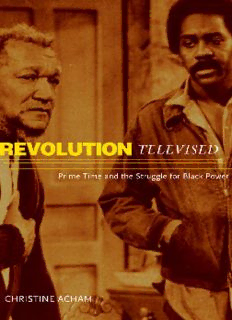
Revolution Televised: Prime Time and The Struggle for Black Power PDF
Preview Revolution Televised: Prime Time and The Struggle for Black Power
Revolution Televised This page intentionally left blank Revolution Televised Prime Time and the Struggle for Black Power Christine Acham University of Minnesota Press Minneapolis / London An earlier version of chapter 4 was previously published as “Sanford and Son: Televising African American Humor,” Spectator: USC Journal of Film and Television Criticism (Spring/Summer 2000). Copyright 2004 by the Regents of the University of Minnesota All rights reserved. No part of this publication may be reproduced, stored in a retrieval system, or transmitted, in any form or by any means, electronic, mechanical, photocopying, recording, or otherwise, without the prior written permission of the publisher. Published by the University of Minnesota Press 111 Third Avenue South, Suite 290 Minneapolis, MN 55401-2520 http://www.upress.umn.edu Library of Congress Cataloging-in-Publication Data Acham, Christine. Revolution televised : prime time and the struggle for Black power / Christine Acham. p. cm. Includes bibliographical references and index. ISBN 0-8166-4431-4 (alk. paper) 1. African Americans on television. 2. Television broadcasting—Social aspects—United States. I. Title. PN1992.8.A34A28 2004 791.45'652996073—dc22 2004009969 Printed in the United States of America on acid-free paper The University of Minnesota is an equal-opportunity educator and employer. 12 11 10 09 08 07 06 05 04 10 9 8 7 6 5 4 3 2 1 This book is dedicated to Ailsa Jeanne Acham and the memory of John L. Acham This page intentionally left blank Contents Acknowledgments ix Introduction xi 1. Reading the Roots of Resistance Television of the Black Revolution 1 2. Was the Revolution Televised? Network News and Black Journal 24 3. What You See Is What You Get Soul Train and The Flip Wilson Show 54 4. This Ain’t No Junk Sanford and Son and African American Humor 85 5. Respect Yourself! Black Women and Power in Julia and Good Times 110 6. That Nigger’s Crazy The Rise and Demise of The Richard Pryor Show 143 Conclusion: Movin’ On Up Contemporary Television as a Site of Resistance 170 Notes 195 Bibliography 217 Index 229 This page intentionally left blank Acknowledgments Revolution Televised: Prime Time and the Struggle for Black Power began while I was a graduate student at the University of South- ern California, and I would like to thank my dissertation commit- tee (Todd Boyd, Tara McPherson, and Darnell Hunt) for support through the PhD program and in completing the dissertation. I especially thank Todd for his belief in my abilities and his encour- agement and guidance throughout the process. Before I get too far, I must recognize those who got me to graduate school in the first place: those who helped me through my somewhat chaotic undergraduate career at Clark University. There was a chance that I might not have obtained a bachelor’s degree at Clark because of financial concerns, and for their support I would like to thank my family: Jeanne, John, Roger, Lee Jay, and Gina- Marie. I would not have graduated from Clark without the guid- ance, support, and assistance of the dean of students at that time, Kevin McKenna. Whether running interference with financial ser- vices, signing off on forms to allow me to take extra units, or just giving me a shoulder to lean on, he always managed to be there for me, and I am forever grateful. I also thank Marvin D’Lugo for his inspiring classes and for encouraging me to apply to film school. To get back to the book at hand, I thank Steve Hanson and the staff of USC School of Cinema-Television Library, the staff of the UCLA Film and Television Archive, and the Museum of Radio and Television in Los Angeles. Even while bogged down in her own re- search, Sharon Sekhon read early versions of this work and helped to ix
Description: